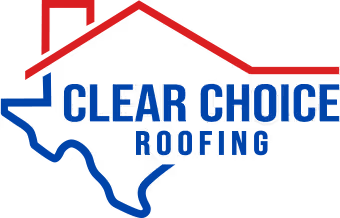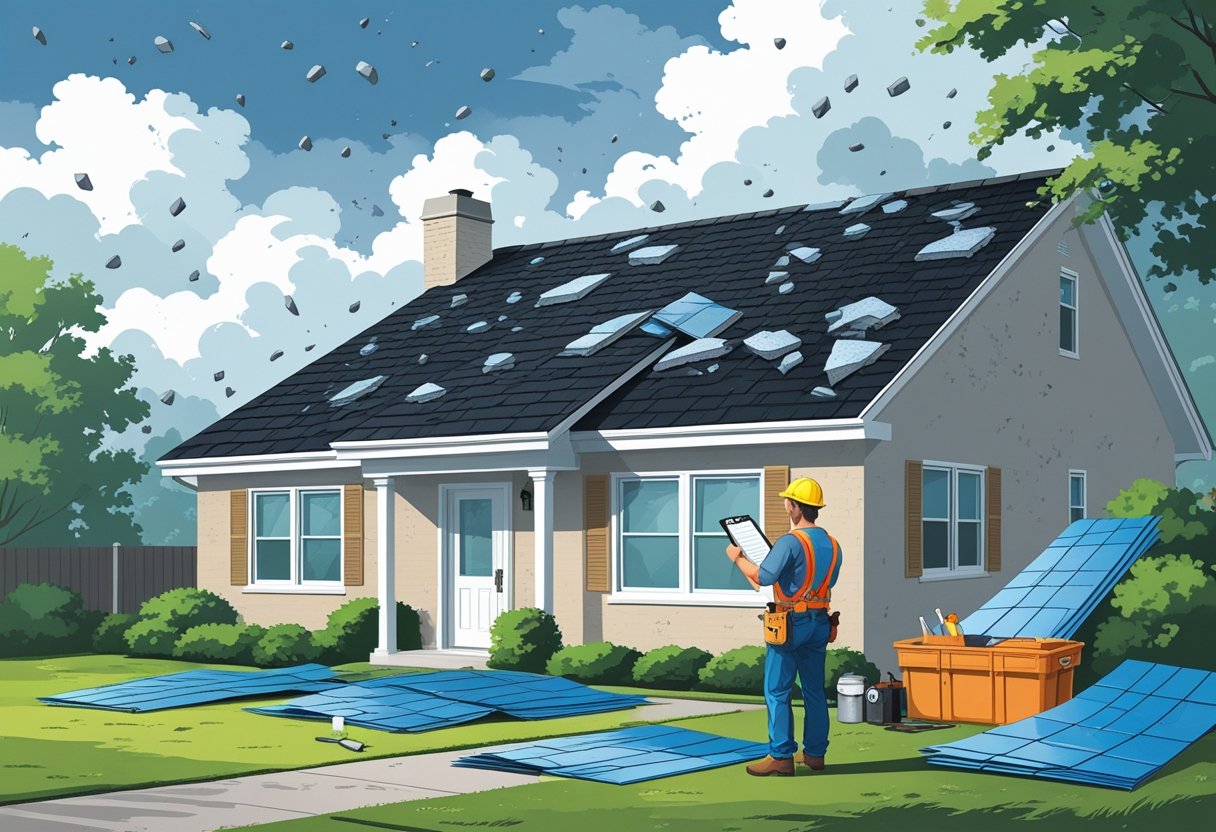When hail damages your roof, costs can vary widely depending on the extent of the impact and the materials involved. On average, hail damage roof repairs cost about $4,250, but minor repairs might be as low as a few hundred dollars, while severe damage could lead to full roof replacement costing tens of thousands. Understanding these costs helps you prepare for what’s ahead and avoid unexpected expenses.
Getting a professional roof inspection is critical to accurately assess damage, preventing small issues from turning into costly repairs. At Clear Choice Roofing, we specialize in guiding homeowners through the repair process, including helping with insurance claims and providing clear, honest estimates tailored to your needs.
If you live in Austin or nearby communities, Clear Choice Roofing offers expert services backed by over a thousand positive reviews and a strong community reputation. Whether your roof needs a simple fix or a full replacement, knowing what to expect in repair costs puts you in control of protecting your home. For more details on hail damage repair pricing, visit this comprehensive guide.
Understanding Hail Damage Roof Repair Costs
Hail damage roof repair costs can vary widely based on several key factors. The size and severity of the damage, the roofing materials involved, and local labor rates all influence what you can expect to pay. Knowing these details will help you plan for repairs and make informed decisions about your roof.
Typical Cost Range for Hail Damage Repairs
The cost to repair roof hail damage typically ranges from about $940 to $4,250 for minor to moderate damage. Smaller repairs might involve replacing a few shingles and sealing leaks, while more extensive damage can push costs toward $21,000 or higher. Full roof replacements or fixing interior water damage caused by leaks are the most expensive outcomes.
Prompt repairs save money over time by preventing worsening problems. For example, untreated hail damage may lead to water infiltration and structural issues that significantly increase expenses. When working with Clear Choice Roofing, you can get a detailed estimate tailored to your hail damage roof repair cost based on the damage extent and material needs.
Factors Impacting Overall Repair Costs
Several factors affect your roof hail damage repair cost:
- Severity of Damage: Minor surface dents cost less than deep punctures or missing shingles.
- Size of Affected Area: Repairing a small section is far cheaper than fixing large portions.
- Material Costs: Higher-quality or specialty roofing materials raise costs.
- Labor Rates: Local market rates vary and influence overall expenses.
- Insurance Coverage: Your policy terms and deductibles impact your out-of-pocket costs.
Hailstorms often cause uneven damage, so your contractor will assess not just visible damage but underlying issues. Clear Choice Roofing also provides support with insurance paperwork to help you understand and manage repair costs effectively.
Cost Variation by Roofing Material
Your roofing material strongly influences hail damage repair prices. Asphalt shingles are the most common and relatively affordable to repair, ranging from $4 to $7 per square foot. Metal roofs, while more durable against hail, typically cost more to repair due to specialized labor and materials.
Other materials like tile or slate are more expensive because they require careful handling and replacement with matching pieces. Additionally, synthetic roofing products may offer better hail resistance but sometimes have higher upfront repair costs.
Choosing durable materials can reduce long-term hail damage roof repair costs by minimizing needed repairs after storms. Clear Choice Roofing can help you select materials suited to your budget and the local hail risks in Austin and nearby communities.
For more detailed cost data, see this page on hail damage roof repair cost.
Types of Roof Damage Caused by Hail
Hail can impact your roof in several specific ways, each affecting the roof’s durability and your home’s safety. Damage ranges from visible missing parts to hidden risks like water intrusion. Understanding these helps you identify issues early and plan repairs effectively.
Missing Shingles and Granule Loss
When hail hits, it can knock shingles completely off your roof or strip away the protective granules on asphalt shingles. Missing shingles expose your roof deck directly to the elements, increasing the risk of leaks and further damage.
Granule loss may seem minor at first but compromises the shingle’s ability to reflect UV rays and protect against water. Over time, this accelerates shingle deterioration, shortening your roof’s lifespan. You might notice bald spots or granules collecting in gutters after a storm.
This type of damage typically requires shingle replacement or patching. Clear Choice Roofing advises quick action to prevent minor issues from escalating into costly repairs.
Dents, Cracks, and Punctures
Hail can cause dents especially on metal roofs, but it can also crack or puncture asphalt shingles. These imperfections break the shingle’s structural integrity and waterproof barrier.
Cracks and punctures allow water to seep beneath the roofing material. Even small nail holes or bruises on shingles can worsen with rain and wind. This leads to leaks and interior water damage if left unchecked.
If you spot dents or cracks, you’ll likely need professional evaluation. Repairs may involve replacing individual shingles or sections to restore full protection.
Water Damage and Mold Risks
One of the most serious consequences of roof hail damage is water infiltration. Missing shingles or punctured areas allow rainwater into your roof’s underlayment and attic.
Water pooling inside can cause wood rot, weaken insulation, and create an environment ideal for mold growth. Mold inside your home poses health risks and can be costly to remediate.
Clear Choice Roofing emphasizes inspecting your roof promptly after hailstorms. Fixing leaks early can prevent hazardous mold development and preserve your home’s structural integrity.
For more about hail damage roof repair and costs, you can explore detailed guides to make informed decisions.
Breakdown of Roof Hail Damage Repair Costs
Hail damage repair costs vary widely depending on your roofing material. Factors such as the extent of damage, material prices, and labor all influence the final price. Understanding these differences can help you budget effectively for the repairs needed to restore your roof’s protection.
Asphalt Shingle Roofs
Asphalt shingles are the most common roofing material and generally the least expensive to repair after hail damage. Repair costs typically range from $300 to $700 per square (100 square feet). Repairs often involve replacing broken or cracked shingles and patching affected areas.
Impact-resistant shingles can cost more initially but reduce repair frequency and severity, making them a smart investment if you live in hail-prone areas. Labor costs fluctuate regionally but expect professional inspection fees to be part of the expense.
With asphalt shingles, minor damage can sometimes be patched, but larger hail impact often requires replacing shingles in sections to ensure long-term durability. Clear Choice Roofing can help assess your roof and ensure repairs are done right.
Metal Roofing Repairs
Metal roofs are durable but vulnerable to dents and dings from hail, which can lead to leaks if untreated. Repair costs for metal roofing range from $500 to $1,200 per square, depending on the severity of the damage. Repairs may include panel replacement, dent removal, or sealing compromised seams.
Metal roofs tend to withstand hail better than asphalt but may require specialized tools and skills for repair. In some cases, localized dents are cosmetic and won't affect the roof’s performance, but you should have a trusted professional evaluate the damage.
Choosing metal roofing with hail-resistant coatings could reduce future hail damage costs. If your metal roof shows significant damage, engaging a reputable company like Clear Choice Roofing ensures thorough repairs to protect your home’s structure.
Tile, Slate, and Wood Roof Costs
Repairing tile, slate, or wood roofs after hail can be more expensive than asphalt or metal due to the fragility and specialized nature of these materials. Tile and slate roofs respond poorly to hail because even small impacts can cause cracking or breaking. Wood shingles also can split or crack.
Costs for these materials typically start around $700 per square and can go much higher depending on roof complexity and material rarity. Replacing individual tiles or slate pieces is labor-intensive. Wood shingles may require replacing entire sections to maintain uniform appearance and protection.
These roofing types often require experienced contractors familiar with traditional materials. Your insurance may cover some or all repair costs if you document the damage promptly. Clear Choice Roofing offers expertise to handle these complex repairs efficiently.
Insurance Coverage and Homeowner Responsibilities
Understanding how insurance works and what is expected from you helps streamline the repair process and avoid costly mistakes. Awareness of your policy details and the claim steps can affect both the outcome and timing of getting your roof fixed after hail damage.
Understanding Homeowners Insurance Policies
Homeowners insurance typically covers hail damage to your roof under the dwelling protection section. However, coverage depends on your policy’s terms, including limits and any exclusions related to roof age or condition. Some policies apply a separate, higher deductible for hail damage, so you should verify this before filing a claim.
Review your policy carefully to understand:
- Coverage limits: Maximum repair amounts allowed
- Deductible amounts: What you pay out-of-pocket
- Exclusions: Conditions like roof age or specific materials not covered
Being clear on these elements helps you anticipate costs and avoid surprises. If your roof is older or has pre-existing damage, coverage might be limited or denied.
Filing a Claim for Hail Damage Repairs
When you suspect hail damage, document it thoroughly with photos and notes. Contact your insurance company promptly to report the damage and initiate a claim.
The claim process generally involves:
- Inspection by an adjuster – to assess damage severity
- Estimate submission – often provided by your roofing contractor
- Approval and payment – minus your deductible
You can work with a trusted local roofer, like Clear Choice Roofing, who can assist with documentation and liaise with your insurer for smoother processing. Filing a claim is recommended when repair costs exceed your deductible significantly. Keep in mind that ignoring hail damage may lead to future claim denials and void warranties.
Being proactive and organized during this process ensures you maximize your homeowners insurance benefits while minimizing delays in restoring your roof.
The Role of Professional Roof Inspections and Contractors
Professional roof inspections and skilled contractors play a critical part in ensuring that hail damage is accurately assessed and properly repaired. They help you avoid hidden issues that could worsen over time and ensure repairs meet quality standards to protect your investment.
Importance of Professional Roof Inspection
A professional roof inspection is vital after a hailstorm because it detects damage you might miss. Hail can cause subtle cracks, bruises, or granule loss that don’t show immediately but compromise your roof’s integrity. An expert inspector evaluates the entire roofing system, including shingles, flashing, and attic vents.
This thorough inspection helps you file accurate insurance claims by providing detailed documentation. With a precise assessment, you can prevent unexpected repair costs and maintain your home's protection. Clear Choice Roofing offers expert inspections that give you peace of mind by uncovering both visible and hidden hail damage efficiently.
Selecting a Qualified Roofing Contractor
Choosing the right roofing contractor ensures that hail damage repair is done according to industry standards using quality materials. Look for certified professionals who have proven experience in hail damage repair and strong local reputations.
A reputable contractor will guide you through the insurance claim process and provide transparent estimates. Avoid companies that cut corners with inferior materials or incomplete repairs. Clear Choice Roofing stands out as a trusted, Owens Corning Platinum Preferred Contractor, committed to using high-grade materials and offering industry-leading warranties. This level of commitment safeguards your home and maximizes the lifespan of your repaired roof.
Prevention and Additional Considerations
Protecting your home against future hail damage involves smart upgrades and attention to more than just the roof. You should also consider improving energy efficiency after repairs and addressing damage to windows and exterior storm protection to safeguard your entire property.
Upgrading to Impact-Resistant Roofing
Choosing impact-resistant roofing materials can significantly reduce the damage from hailstorms. These materials, typically classified as Class 4 impact resistant, include specially designed shingles that withstand hail strikes without cracking or breaking.
Installing this type of roofing lowers the chance of costly repairs and can extend the life of your roof. While the initial investment is higher, insurance companies often offer discounts for impact-resistant roofs, helping offset some of the costs. You can also expect better protection during severe storms, which is crucial if you live in hail-prone areas like Austin.
Clear Choice Roofing specializes in installing impact-resistant roofing systems that meet Texas building codes and provide long-term durability. Upgrading this way ensures that your roof is prepared to handle future hail events more effectively.
Improving Energy Efficiency Post-Repair
After hail damage roof repair, improving your home’s energy efficiency is a practical step. New roofing materials often come with better insulation and reflective properties that reduce heat absorption.
Consider upgrading your roof insulation and ventilation systems during repairs. This will help regulate your home’s temperature, lowering cooling costs, especially during the hot Texas summers. Additionally, some energy-efficient roofing options may qualify for local rebates or incentives.
Post-repair energy improvements not only reduce utility bills but also increase your home’s overall comfort. Discuss these options with your roofing professionals to select materials that balance durability and energy savings effectively.
Associated Repairs: Windows and Storm Protection
Hail often damages windows and exterior components, so repairs should go beyond the roof. Replacing broken or cracked windows promptly is essential to maintain your home's integrity and prevent water intrusion.
Installing storm shutters or hail guards adds an extra layer of protection to vulnerable areas. These protective measures can reduce the risk of window breakage and help minimize insurance claims over time.
When coordinating hail damage roof repair, consider combining roof work with window replacement and storm protection installation. Clear Choice Roofing can assist you in identifying all affected areas and provide solutions that protect your entire home from future storm damage.
Frequently Asked Questions
Understanding what affects hail damage roof repair costs helps you better prepare for estimates. Costs can vary based on your roof’s materials, the extent of damage, insurance factors, and timing considerations.
What factors influence the cost of repairing a roof with hail damage?
Repair expenses depend on damage severity, roofing material, labor rates, and location. Additional factors include whether the roof needs partial repairs or a full replacement.
Other costs like debris removal and permits may apply. Prompt repairs can prevent more extensive damage and higher future costs.
How does roof material type affect the price of hail damage repairs?
Asphalt shingles generally cost less to repair, around $300 to $700 per 100 square feet. Metal roofs are more durable but repairs can range from $500 to $1,200 per square due to dent removal or panel replacement.
Specialty roofs, like tile or slate, usually require higher repair costs because of material expenses and labor complexity.
Can the size and severity of hail impact the repair costs for a damaged roof?
Larger hailstones cause more significant damage, increasing repair needs and costs. Severe storms may result in multiple damaged areas, requiring extensive materials and labor.
Minor dents might only need spot repairs, while widespread impact can lead to a full roof replacement.
Is it possible to get an estimate for hail damage roof repair without an on-site inspection?
Estimates based on photos or descriptions can be provided but are less accurate. A thorough on-site inspection is advised for reliable assessments of damage scope and repair needs.
Clear Choice Roofing offers free, no-obligation inspections to give you detailed and accurate estimates.
How do insurance coverages typically handle hail damage repair expenses?
Most homeowner insurance policies cover hail damage repairs, usually after you pay a deductible. Insurers may require professional inspections and adjuster reviews before authorizing costs.
Understanding your policy terms helps set realistic expectations about covered amounts and claim processes.
Are there any seasonal considerations that affect the timing and cost of fixing a hail-damaged roof?
Roof repairs during peak storm seasons may face longer wait times and higher labor rates due to demand. Scheduling repairs in off-peak months can reduce costs and speed up service.
Weather conditions also impact how quickly and easily work can be completed on your roof.



